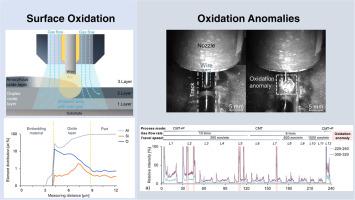Additive Manufacturing ( IF 11.0 ) Pub Date : 2021-03-19 , DOI: 10.1016/j.addma.2021.101958 Tobias Hauser , Raven T. Reisch , Philipp P. Breese , Yogesh Nalam , Kaivalya S. Joshi , Katharina Bela , Tobias Kamps , Joerg Volpp , Alexander F.H. Kaplan

|
Wire Arc Additive Manufacturing is a near-net-shape machining technology that enables low-cost production of large and customised metal parts. In the present work, oxidation effects in Wire Arc Additive Manufacturing of the aluminium alloy AW4043/AlSi5(wt%) were investigated. Two main oxidation effects, the surface oxidation on aluminium parts and the oxidation anomalies in aluminium parts were observed and analysed. The surface oxidation on aluminium parts changed its colour during Wire Arc Additive Manufacturing from transparent to white. In the present work, it was shown by high-speed imaging that this change in the surface oxidation took place in the process zone, which was covered by inert gas. Since the white surface oxidation formed in an inert gas atmosphere, it was found that the arc interacts with the existing amorphous oxide layer of the previously deposited layer and turns it into a white duplex (crystalline and amorphous) oxide layer. In addition to the analysis of the white surface oxidation, oxidation anomalies, which occur at low shielding from the environment, were investigated. It was shown by physical experiments and Computational Fluid Dynamics simulations, that these oxidation anomalies occur at inadequate gas flow rates, too big nozzle-to-work distances, process modes with too high heat input, or too high wire feed rates. Finally, a monitoring method based on light emission spectroscopy was used to detect oxidation anomalies as they create peaks in the spectral emission when they occur.
中文翻译:

铝合金电弧增材制造中的氧化
线电弧增材制造是一种接近最终形状的加工技术,可以低成本地生产大型和定制的金属零件。在本工作中,研究了铝合金AW4043 / AlSi5(wt%)的电弧增材制造中的氧化作用。观察并分析了两个主要的氧化作用,即铝零件的表面氧化和铝零件的氧化异常。线材增材制造过程中,铝零件的表面氧化将其颜色从透明更改为白色。在当前工作中,通过高速成像显示,表面氧化的这种变化发生在被惰性气体覆盖的工艺区域中。由于白色表面氧化是在惰性气体气氛中形成的,已经发现,电弧与先前沉积的层的现有非晶氧化物层相互作用并将其变成白色双相(晶体和非晶)氧化物层。除了分析白色表面氧化之外,还研究了在对环境的低屏蔽下发生的氧化异常。物理实验和计算流体动力学模拟表明,这些氧化异常是在气体流量不足,喷嘴到工作距离太大,热量输入过高的工艺模式或焊丝进给速度过高的情况下发生的。最后,基于发光光谱的监测方法被用于检测氧化异常,因为氧化异常在发生时会在光谱发射中产生峰值。除了分析白色表面氧化之外,还研究了在对环境的低屏蔽下发生的氧化异常。物理实验和计算流体动力学模拟表明,这些氧化异常是在气体流量不足,喷嘴到工作距离太大,热量输入过高的工艺模式或焊丝进给速度过高的情况下发生的。最后,基于发光光谱的监测方法被用于检测氧化异常,因为氧化异常在发生时会在光谱发射中产生峰值。除了分析白色表面氧化之外,还研究了在对环境的低屏蔽下发生的氧化异常。物理实验和计算流体动力学模拟表明,这些氧化异常是在气体流量不足,喷嘴到工作距离太大,热量输入过高的工艺模式或焊丝进给速度过高的情况下发生的。最后,基于发光光谱的监测方法被用于检测氧化异常,因为氧化异常在发生时会在光谱发射中产生峰值。这些氧化异常是在气体流量不足,喷嘴到工作距离太大,热量输入过高的工艺模式或焊丝进给速度过高的情况下发生的。最后,基于发光光谱的监测方法被用于检测氧化异常,因为氧化异常在发生时会在光谱发射中产生峰值。这些氧化异常是在气体流量不足,喷嘴到工作距离太大,热量输入过高的工艺模式或焊丝进给速度过高的情况下发生的。最后,基于发光光谱的监测方法被用于检测氧化异常,因为氧化异常在发生时会在光谱发射中产生峰值。



























 京公网安备 11010802027423号
京公网安备 11010802027423号